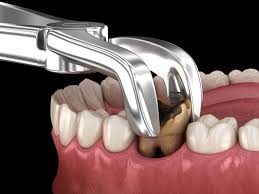Tooth extraction

Tooth extraction is the removal of a tooth from its socket in the jawbone. It's typically performed by a dentist or oral surgeon and may be necessary for various reasons, including severe decay, advanced gum disease , infection, overcrowding, trauma, or preparation for orthodontic treatment.
Here's an overview of the tooth extraction process:
- 1.Evaluation:
The dentist examines the tooth and may take X-rays to assess its condition and determine the best course of action. They will also review the patient's medical history to identify any potential risks or complications.
- 2. Anesthesia:
: Local anesthesia is usually administered to numb the area around the tooth, ensuring that the patient remains comfortable throughout the procedure. In some cases, sedation may also be used to help the patient relax.
- 3.Extraction:
Using specialized instruments, the dentist loosens the tooth from its socket and gently removes it. In some cases, the tooth may need to be divided into smaller pieces for easier removal, particularly if it's impacted or broken.
- 4.Post-Extraction Care:
After the tooth is extracted, the dentist may place gauze over the socket to control bleeding and promote clot formation. They will provide instructions on how to care for the extraction site, including proper oral hygiene practices and any medications that may be needed to manage pain or prevent infection.
- 5.Healing:
The extraction site will typically heal within a few days to a few weeks, depending on the complexity of the extraction and the individual's healing process. During this time, it's essential to follow the dentist's instructions and avoid activities that could disrupt the healing process, such as smoking or vigorous rinsing.
In some cases, particularly for impacted wisdom teeth or complex extractions, surgical extraction may be necessary. This involves making an incision in the gum tissue to access the tooth and may require stitches to close the wound.
While tooth extraction is a common dental procedure, it's generally considered a last resort when other treatment options are not feasible or effective. Whenever possible, dentists will strive to preserve natural teeth through restorative treatments such as fillings, crowns, or root canal therapy. However, in cases where extraction is necessary, it can help alleviate pain, prevent complications, and restore oral health and function.
Services
Dental services
know more about your treatment , symptons , procedure , costs and FAQ's.